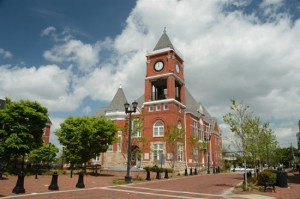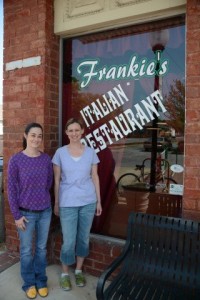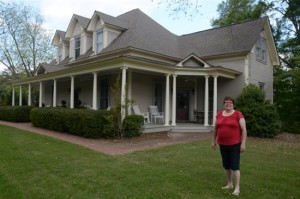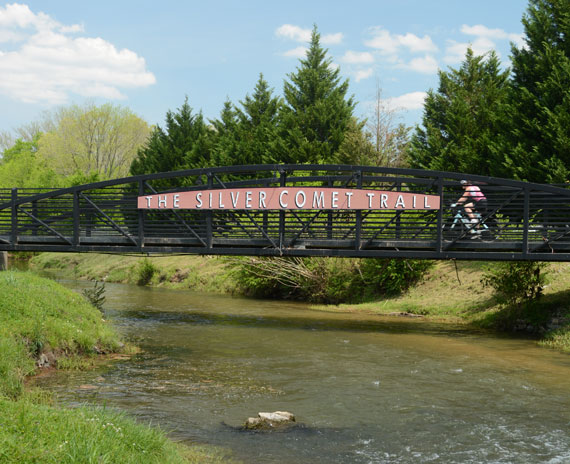By Rick Pruetz
The Silver Comet rail-trail winds through 61 miles of northern Georgia countryside, linking Smyrna, a suburb north of Atlanta, with the Chief Ladiga Trail in Alabama.
Although the Silver Comet is already the nation’s longest paved rail trail, a 2013 study initiated by the Northwest Georgia Regional Commission recommends more than doubling its length, with spurs to nearby commercial centers plus longer extensions to Marietta, Rome, and Atlanta’s growing bike path network. These extensions won’t be cheap. But the study persuasively argues that these improvements will be well worth the effort in terms of economic development as well as exercise, recreation, and green transportation.
Currently, 1.9 million users per year flock to the Silver Comet Trail, which got its name from the train that once sped passengers between New York City and Birmingham, Alabama. Survey results conclude that trail users generate $57 million in direct spending annually on food, clothing, lodging and other trip-related items. The beneficiaries include local Georgia businesses like Frankie’s Italian Restaurant in Rockmart, the Ragsdale Inn in Dallas, and Boneshaker Bicycles in Powder Springs, where Jim Bell and Hamlet Harris rent and repair bikes only a few feet from the trail.
The study estimates that the Silver Comet Trail boosts the value of previously-developed property by $180 million, generating more than $2 million of additional property tax revenues for the jurisdictions and school districts adjacent to the trail. The trail is also capable of attracting another $41 million in new development to nearby communities.
The $57 million of direct spending estimated by the study creates an extra $61 million in indirect impact as this revenue ripples through the economy. The total direct and indirect spending of almost $120 million within the State of Georgia supports roughly 1,300 jobs and $37 million in earnings. In addition, the combined direct and indirect spending generates roughly $3.5 million in income tax, sales tax and business tax revenues.
Many trail users live in communities that are not adjacent to the trail including 23 counties in eight different states, some as far away as the state of Washington. Ramona Ruark, Cedartown Main Street director, adds that the visitor log in the Cedartown Welcome Center, a replica of the original train station, shows that trail users come from other countries as well. Over one-fifth of those who responded to a 2013 survey stay overnight when visiting the trail. In fact, the study found that these bicycle tourists spend roughly $20 million annually on their visits.
Trail-adjacent business owners are excited about the proposal to double the length of the trail. Longer trails mean more riders, more business, more jobs, more tax revenues and, consequently, more prosperity. The report estimates that expanding the trail from 61 to 127 miles will cost $59 million. But as the study also shows, the returns will more than outweigh the costs.
Image: The Silver Comet Trail at Rockmart, Georgia. Photo by Rick Pruetz. Used with permission.
The Profitable Trail of the Silver Comet Trail

I recently pedaled the Silver Comet Trail from Smyrna, Ga., a suburb north of Atlanta, to Cedartown, a small city with an historic downtown near the Alabama border. My ride through the mostly wooded countryside was so pleasant, I didn’t want it to end.
Apparently, I’m not alone.
A 2013 study by the Northwest Georgia Regional Planning Commission recommends more than doubling the length of the Silver Comet Trail —at its “tail” end—with spurs to nearby commercial centers and longer extensions to Marietta, Rome and Atlanta’s growing bike-path network.

As illustrated in their 2013 “Silver Comet Trail Economic Impact Assessment and Planning Study,” trails are well-established economic engines.
The study finds that every dollar invested in trails creates at least three dollars of return from tourism and recreation-related activities like equipment rentals, restaurants and lodging.
As an added note: Some studies have documented much higher rates of return, such as 900 percent in North Carolina’s Outer Banks and 1,180 percent in Kansas City!
In its present 61-mile makeup, 1.9 million users flock to the Silver Comet Trail each year, which got its name from the train that once sped passengers between New York City and Birmingham, Ala. Survey results conclude that Silver Comet Trail users generate $57 million in direct spending annually on food, clothing, lodging and other trip-related items.

One of the beneficiaries: Frankie’s Italian Restaurant in Rockmart, where cyclists can memorialize their rides by writing on a wall of fame!
The $57 million of direct spending estimated by the study creates an additional $61 million in indirect impact as dollars ripple through the economy. The total spending of almost $120 million in Georgia supports roughly 1,300 jobs and $37 million in earnings. In addition, the combined direct and indirect spending generates roughly $3.5 million in income tax, sales tax and business tax revenues.
Many trail users live in communities that are not adjacent to the trail; the study documents trail users from 23 counties in 8 different states—some as far away as Washington.
Ramona Ruark, Cedartown Main Street director, adds that the visitor log in the Cedartown Welcome Center—a replica of the city’s original train station—documents trail users from other countries as well.
More than one-fifth of the people who responded to a 2013 survey stay overnight when visiting the trail—not surprising since roughly 15-million people live outside Georgia but within a 150-mile radius of the Silver Comet Trail. In fact, the study found that these bicycle tourists spend roughly $20 million annually on their visits.
Jackie Crum, owner of the Ragsdale Inn just off the trail in Dallas, estimates that more than half of her guests are Silver Comet Trail riders. “Tourism is wonderful for the local economy,” she explains. “It generates income without the infrastructure needs and tax burdens of residential development.”

Now, let’s talk about property values…
Several organizations have calculated the residential property value increases associated with proximity to trails and green space. A fact sheet from Rails-to-Trails Conservancy reports that properties along a trail in Brown County, Wis., fetched a 9 percent premium, and a regional greenway in Apex, N.C., added $5,000 to the sales price of adjacent homes in the Shepherd’s Vineyard development.
The Silver Comet Trail study summarizes that trails are responsible for a 4 to 7 percent increase in property value for homes within one-quarter mile. The study also estimates that the trail is capable of attracting developers to build new houses on vacant land near the trail with a value of up to $41 million, generating an additional half-million dollars in property tax revenue.
Trail-adjacent business owners are excited about the proposal to double the length of the trail. Longer trails mean more riders, more business, more jobs, more tax revenues and, consequently, more prosperity.
Photos by Rick Pruetz. Top: Silver Comet Trail wildlife area; top right: Historic Downtown Dallas, Ga.; middle left: Frankie’s Italian Restaurant in Rockmart, Ga.; bottom right: Jackie Crum in front of the Ragsdale Inn in Dallas, Ga.
…………………………………………………………

Rick Pruetz is a planning consultant specializing in open space preservation. He is also an avid cyclist and occasionally writes about the economic benefits of rail trails.


Planning Practice Special Feature — Practicing Planner — Spring 2014

